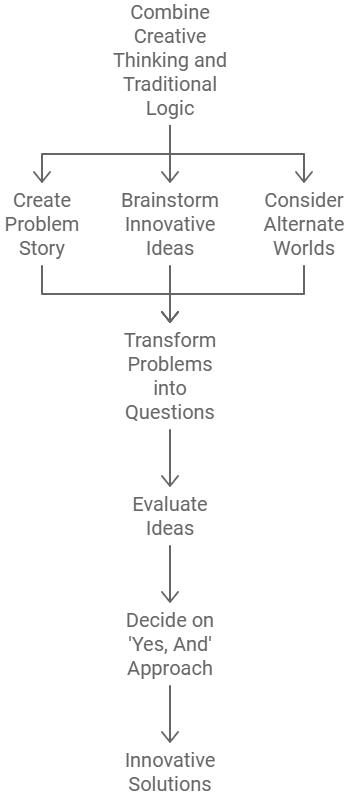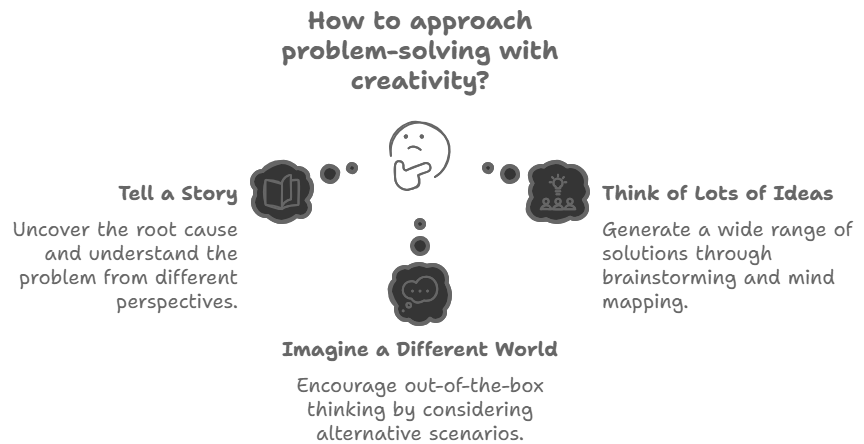Deep Dive: Creative Problem-Solving Analysis
Creative problem-solving is similar to being a detective. You search for clues and put them together to solve a tricky case. This article will explore the art of creative problem-solving analysis. We’ll look at brainstorming innovative ideas, testing, and refining solutions. We’ll also explore strategies and techniques to help you become a master problem-solver. So, grab your magnifying glass and uncover the secrets of creative problem-solving!
What Does It Mean to Solve Problems Creatively?
Finding Balance In Different Ways of Thinking

Different ways of thinking can help in problem-solving and decision-making. They offer diverse perspectives and alternative solutions.
For example, combining creative thinking with traditional logic allows exploring out-of-the-box ideas while considering practical approaches.
Strategies to achieve this balance include creating a problem story to view the issue from different angles, brainstorming for innovative ideas, and considering alternate worlds for unconventional solutions.
Integrating these strategies helps effectively incorporate creative thinking into problem-solving without neglecting traditional logic.
Cultivating creative thinking skills can be enhanced through online courses and resources focusing on design thinking and creative problem-solving. This can broaden problem-solving abilities and strengthen the capacity to approach challenges creatively.
Changing Problems into Questions
Telling a story about the problem can help change it into a question. It provides a clear structure and context for understanding the issue.
For example, someone facing a particular problem at work can create a problem story to outline the challenges they’re experiencing. This can then be turned into questions to guide the problem-solving process.
In creative problem-solving, considering alternate worlds can also help transform problems into questions. This prompts individuals to think beyond their current reality. Imagine what the world would be like if the problem didn’t exist, opening up new perspectives and generating innovative questions for addressing the issue.
Lastly, brainstorming is an effective way to generate many ideas when thinking creatively about solving a problem. Techniques like mind mapping, random word association, or role-playing are involved. All of these encourage the exploration of different paths and ultimately lead to insightful questions for problem-solving.
Waiting to Decide if Ideas Are Good
Waiting to decide if ideas are good involves specific strategies. These include evaluating long-term impact, seeking feedback from diverse perspectives, and conducting thorough research. Individuals can cultivate patience and open-mindedness by assessing an idea from various angles and gathering information. Rushing to judge an idea can lead to missed opportunities, limited creativity, and potential adverse outcomes.
It is essential to allow ideas to develop fully and consider their potential before making a final decision.
Saying ‘Yes, And’ More Than ‘No, But’
Individuals can improve problem-solving by actively listening and being open to new ideas and perspectives. Shifting from “No, But” to “Yes, And” involves building upon the ideas of others rather than shutting them down. Ways to encourage this approach include promoting trust and open communication in the team. “Yes, And” can lead to more innovative solutions by exploring various possibilities and combinations of ideas.
It also encourages a more inclusive problem-solving process, leading to greater engagement from team members.
How Creative Solving Connects to Thinking by Design
Connecting creative problem-solving to thinking by design means using innovative approaches to address challenges. This involves a strong emphasis on human-centered solutions. By applying design thinking principles, individuals can take a holistic approach to problem-solving. They consider not only the immediate issue but also the broader context and potential impact on stakeholders.
For example, an organization can use design thinking principles to develop products and services. They aim to effectively meet their target audience’s needs and preferences, ultimately leading to greater customer satisfaction and loyalty.
Storytelling can be a powerful tool for creatively solving problems and connecting to thinking by design. It allows individuals to empathize with others and better understand the situation. Creating a narrative around the issue enables people to explore different perspectives and identify unique solutions. These solutions align with the needs and values of the end-users.
For instance, a healthcare organization can use storytelling to understand the experiences of patients and healthcare providers. This can lead to developing more practical and empathetic solutions that enhance patient care and satisfaction.
Imagining a different world can help in creatively solving problems and connecting to thinking by design. This allows individuals to envision diverse scenarios and possibilities. This exercise encourages individuals to think outside the box and consider unconventional yet practical solutions.
For instance, urban designers can imagine alternate worlds in urban planning to develop innovative city designs. These designs prioritize sustainability, accessibility, and community well-being, fostering creative and forward-thinking urban development strategies.
Tools We Use to Solve Problems with Creativity

Telling a Story about the Problem You Have
The user had trouble finding a page on LinkedIn. This made it confusing and complicated to get the information they wanted.
LinkedIn showed an error message in different languages, giving users options to go back or get help from the Help Center. This was to help the user immediately and provide more support if needed.
This way, LinkedIn could fix the problem and help all its users worldwide.
Thinking of Lots of Ideas
To think of many ideas when solving a problem, individuals can do activities like mind mapping, brainstorming, and free writing. These help generate a wide range of ideas without judgment.
Strategies such as examining the issue from different angles, involving diverse team members, and setting aside dedicated time for brainstorming sessions can encourage creative thinking and generate numerous solutions.
It’s important to wait and consider an idea’s potential before dismissing it because initial judgments can stifle innovation. By allowing time for reflection and exploration, individuals may uncover hidden opportunities or unforeseen benefits associated with an idea. This fosters a culture of open-mindedness and supports comprehensive problem-solving.
Imagining If the World Was Different
Imagining if the world was different can help in solving problems creatively. It encourages individuals to think outside the box and consider alternative solutions. By envisioning a different reality, individuals can develop innovative ideas and approaches.
Tools such as creating a problem story, brainstorming, and considering alternate worlds can be used to imagine and solve problems with creativity. Creating a problem story involves identifying the key issues at hand. Brainstorming allows for the generation of multiple ideas and solutions. Considering alternate worlds prompts individuals to consider different scenarios and envision unique ways to tackle challenges.
Creative problem-solving can help create a better world. It fosters innovation and addresses complex issues with fresh perspectives. It enables individuals and organizations to find sustainable solutions to environmental, social, and economic problems. By encouraging creative thinking, new technologies, processes, and systems can be developed that benefit society as a whole.
Keep Getting Better at Solving Problems
Individuals can improve problem-solving by incorporating different ways of thinking. They can use logical reasoning and creative thinking to explore unconventional solutions. Divergent and convergent thinking can help to expand problem-solving approaches and draw from a wide range of ideas.
Problem stories, brainstorming, and considering alternate worlds can enhance creative problem-solving skills. Problem stories aid in understanding the issue and developing innovative solutions. Brainstorming allows for exploring different perspectives and generating creative ideas. Considering alternate worlds encourages envisioning new possibilities and thinking outside the box.
Creative problem-solving emphasizes empathy, ideation, and prototyping in problem-solving processes. Integrating design thinking principles can help individuals understand user needs, generate innovative solutions, and improve problem-solving approaches. This approach bridges the gap between problem-solving and design thinking, contributing to a holistic and innovative problem-solving process.

Vizologi is a revolutionary AI-generated business strategy tool that offers its users access to advanced features to create and refine start-up ideas quickly.
It generates limitless business ideas, gains insights on markets and competitors, and automates business plan creation.


